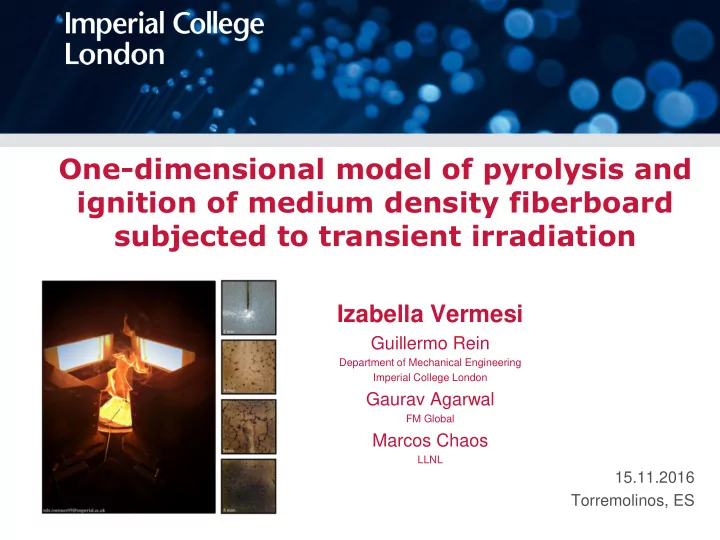

One-dimensional model of pyrolysis and ignition of medium density fiberboard subjected to transient irradiation Izabella Vermesi Guillermo Rein Department of Mechanical Engineering Imperial College London Gaurav Agarwal FM Global Marcos Chaos LLNL 15.11.2016 Torremolinos, ES
Presentation Outline Pyrolysis MDF under MDF transient model experiments irradiation Constant + Previous MDF: transient Parametric work with uses + irradiation study polymers manufacture results 1
What is Pyrolysis? Pyrolysis = the process through which the solid undergoes a chemical decomposition and transforms into a gaseous fuel 2
Importance of Pyrolysis Ignition PYROLYSIS Flame spread 3
Constant vs. transient 45 35 30 Heat Flux [kW/m 2 ] Heat Flux [kW/m 2 ] 40 Heat Flux [kW/m 2 ] 30 25 35 25 30 20 20 25 15 20 15 15 10 10 10 5 5 5 0 0 0 0 500 1000 1500 0 100 200 300 400 500 0 500 1000 1500 Time [s] Time [s] Time [s] 4
Transient scenario: state of the art Linear ramps: • Wood: Univ. Zaragoza (2000), USTC (2007), USTC (2016) • MDF: FM Global (2016) • Polymers: Univ. Edinburgh (2012) • t 2 parabolic heat flux: • Wood: USTC (2016), Univ. Waterloo (2016) • Parabolic pulses: • Forest fuels: Univ. Exeter (2015) • PMMA: Imperial College (2015) • MDF: Imperial College (2016) • 5
Vermesi et al., Combust. Fl. 2016 6
Vermesi et al., Combust. Fl. 2016 7
Vermesi et al., Combust. Fl. 2016 8
Medium density fiberboard http://ifabstudio.com/wp-content/uploads/2014/03/MDF_DETALE.jpg Engineered wood product obtained from wood fibers glued • together under heat and pressure Use in the indoor built environment: furniture, separating • walls 9
MDF experiments FPA experiments using MDF samples with thickness of 30 mm • Surface temperature measured with an IR pyrometer, mass • loss measured with load cell 10
Irradiation Curves 11
MDF model 1D model in Gpyro (Lautenberger, Fire Saf. J., 2009) • Boundary conditions: • MDF Energy equation: • Arrhenius equation for pyrolysis rate • 12
MDF model 13
MDF model 14
MDF model 15
MDF results: constant irradiation 40 Measurement 600 Model Predictions Irradiation [kW/m 2 ] Temperature [ ° C] Irradiation 30 450 20 300 10 150 0 0 0 100 200 300 400 500 Time [s] 16
MDF results: constant irradiation 40 Measurement Irradiation [kW/m 2 ] 600 Temperature [ ° C] Model Predictions Irradiation 30 450 20 300 10 150 0 0 0 100 200 300 400 500 Time [s] 8 40 Measurement Mass loss rate [g/m 2 s] Irradiation [kW/m 2 ] Model Predictions Irradiation 6 30 4 20 2 10 0 0 17 0 100 200 300 400 500 Time [s]
MDF results: transient irradiation 40 Measurement Model Predictions 600 Irradiation [kW/m 2 ] Irradiation Temperature [ ° C] 30 450 20 300 10 150 0 0 0 200 400 Time [s] 18
MDF results: transient irradiation 40 Measurement Model Predictions Irradiation [kW/m 2 ] 600 Temperature [ ° C] Irradiation 30 450 20 300 10 150 0 0 0 200 400 Time [s] 8 40 Measurement Mass loss rate [g/m 2 s] Irradiation [kW/m 2 ] Model Predictions Irradiation 6 30 4 20 2 10 0 0 0 100 200 300 400 500 19 Time [s]
Parametric study • Thermal properties that remain constant with temperature vs. temperature-dependent properties • Influence of the drying step in the kinetics scheme 20
Constant vs. temperature dependent properties 21
Influence of drying 22
Conclusions MDF subjected to transient irradiation ignited in all scenarios • MDF experiments modelled in 1D in Gpyro (no optimization, only • values from literature and measurements) Surface temperatures are well predicted for both materials • Mass loss rate is predicted qualitatively • Drying is an essential step in modelling MDF • Using temperature dependent properties improves the results slightly, • but is not as influential as drying 23
Thank you for your attention! Acknowledgements: Questions? 24
Recommend
More recommend